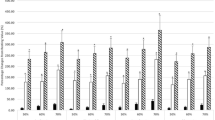Summary
The generation of tumour necrosis factor (TNF) and tissue factor activity in lipopolysaccharide (LPS) stimulated blood were studied in 25 healthy subjects before and after physical exercise of different intensities. Of the subjects a group of 9 were athletes who trained once to twice every day of the week, a second group of 8 exercised 3–7 times a week, and a third group of 8 exercised 4–5 times a month. The production of TNF in freshly drawn LPS stimulated blood in heparin, drawn from top athletes at rest was significantly lower than in the other subjects. The LPS induced concentrations of TNF-α of 2.73 (SEM 1.05) ng · ml−1 in the blood of the top athletes compared to 5.08 (SEM 0.7) ng · ml−1 and 7.6 (SEM 1.6) ng · ml−1, respectively, in the other two groups. The group that trained the least had the highest values. Immediately after exercise, the monocytes appeared to be less responsive to LPS stimulation, as a reduction of 47%–48% was observed in the top athletes and in the other group of well-trained individuals. The group that trained the least, which was also subjected to the least stressful exercise, had a 33% reduction in TNF production. Within 6 h the TNF concentration was back to pre-exercise values. Within 6 h the TNF concentration was back to pre-exercise values. In contrast to TNF production, the LPS induced tissue factor activity of monocytes was significantly higher in the top athletes and in the group of well-trained individuals when measured immediately after 10 min of exercise compared to pre-exercise values. The increase in tissue factor activity was probably a reflection of simultaneous granulocyte- and platelet activation which is known to enhance LPS induced tissue factor activity in monocytes. Except for the period immediately after exercise, there was a significant correlation between LPS induced TNF and tissue factor activity in the whole blood of the participants. In conclusion, hard physical training appeared to suppress the availability of TNF in stimulated blood. This was even more pronounced immediately after strenuous physical exercise.
Similar content being viewed by others
References
Bøyum A (1976) Isolation of lymphocytes, granulocytes and macrophages. Scand J Immunol 5:9–15
Cerami A, Beutler B (1988) The role of cachectin/TNF in endotoxic shock and cachexia. Immunol Today 9:28–31
Evans WJ, Meredith CN, Cannon JG, Dinarallo CA, Frontera WR, Hughes VA, Jones BH, Knuttgen HG (1986) Metabolic changes following eccentric exercise in trained and untrained men. J Appl Physiol 61:1864–1868
Fitzgerald L (1988) Exercise and the immune system. Immunol Today 9:337–339
Østerud B, Bjørklid E (1982) Factor VII associated with monocytes in endotoxin stimulated blood. Biochem Biophys Res Commun 108:620–626
Østerud B, Bøgwald J, Lindahl U, Seljelid R (1981) Production of blood coagulation factor V and tissue thromboplastin by macrophages in vitro. FEBS Lett 127:154–156
Østerud B, Olsen JO, Wilsgård L (1989a) Effect of strenuous exercise on blood monocytes and their relation to coagulation. Med Sci Sports Exerc 21:374–378
Østerud B, Hansen J-B, Olsen JO, Wilsgård L (1989b) Thromboplastin induced synthesis in monocytes in blood: effect of granulocytes and platelets (abstract 1083). Thromb Haemost 62:348
Waage A, Halstensen A, Espevik T (1987) Association between tumour necrosis factor in serum and fatal outcome in patients with meningococcal disease. Lancet 1, 355–357
Author information
Authors and Affiliations
Rights and permissions
About this article
Cite this article
Kvernmo, H., Olsen, J.O. & Østerud, B. Changes in blood cell response following strenuous physical exercise. Europ. J. Appl. Physiol. 64, 318–322 (1992). https://doi.org/10.1007/BF00636218
Accepted:
Issue Date:
DOI: https://doi.org/10.1007/BF00636218



